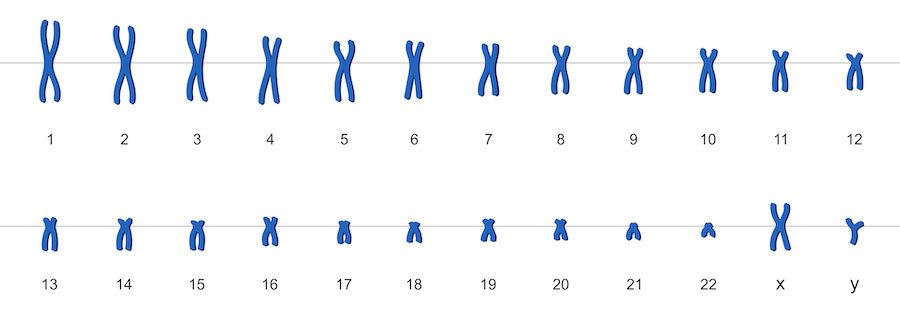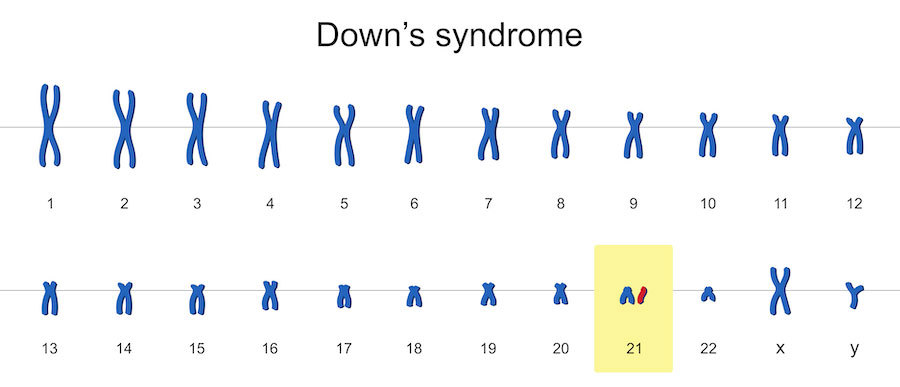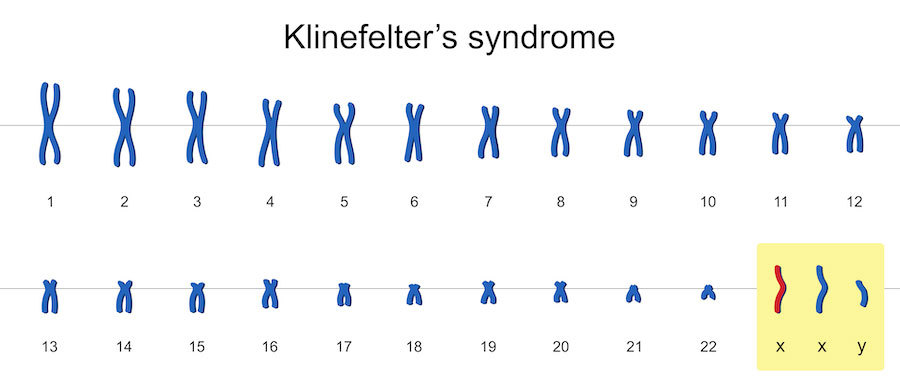
How rare is DNA mosaicism of the sex chromosomes?
April 6, 2016

- Related Topics:
- Mosaicism,
- Trisomy/Aneuploidy,
- Chromosomes
A curious adult from Florida asks:
“I am looking for any information relevant to an adult diagnosis of a DNA mosacism of the sex chromosomes. Most recent lab states 47,XXY, 46,XX. Is this karyotype truly so rare that it has no name? Any insight would be appreciated.”
Your chromosome arrangement or karyotype is indeed rare enough that it doesn’t have a name. One study said that there have only been 10 or so reported cases. This is really rare!
But that isn’t to say that this type of thing is rare. It isn’t. Having two sets of DNA is actually pretty common. It is just that your particular combination is rare (47,XXY along with 46, XX).
This isn’t to say that having some of your cells have one set of DNA and the rest have a second set is all that rare. It isn’t. It is just that your particular combination is.
What I want to do for the rest of the answer is go into a little more detail about how conditions like this one can happen. To do that, we need to take a step back and talk about chromosomes.
Chromosomes
The genetic test that you had done looks at a person’s chromosomes. Chromosomes are simply DNA that’s all packaged up into structures that we can see under a microscope. And DNA is the set of instructions that tells your body how to make every part of you.
We usually have two copies of each chromosome like this:

Chromosomes come in pairs because we get one of each from our mom, and one of each from our dad. Sometimes, though, someone can have three copies of a chromosome instead of two.
Here’s an example of what one of these kinds of karyotypes might look like:

Can you see the extra copy of chromosome 21 highlighted in yellow? This causes a condition called Down syndrome.
These extra chromosomes come from either the egg or sperm and happen purely by chance. With some of these conditions there is an increased chance of them happening as the mother gets older. However, it’s still a random event and there's nothing someone did or didn't do to cause there to be an extra chromosome.
Another set of similar, relatively common conditions are called sex chromosome aneuploidies. As you might guess, these involve the sex chromosomes! These are the 23rd pair of chromosomes that determines if a person is biologically male or female.
Usually, females have two X chromosomes (XX) and males have one X and one Y chromosome (XY). If a person has an extra copy of the X or Y chromosome they are still male or female, but they can have some medical symptoms. Generally, these are pretty mild.
Someone with an extra or missing sex chromosome may have learning differnces or subtle differences in their bodies. They may also have problems having children.
In fact, this difficulty with having children is often how these conditions get diagnosed. A person may live their whole life with this difference in their chromosomes and not know it until they have trouble having children and see a doctor.
Here is an example of having two X’s and a Y:

47,XXY is an example of one of these sex chromosome conditions. It is called Klinefelter syndrome and people with this karyotype are generally male, just with an extra X chromosome.
Klinefelter syndrome is pretty common, affecting somewhere between 1 in 500 to 1 in 1,000 male births. And it may even be more common, as some men have such subtle findings that they don’t get diagnosed. People with Klinefelter syndrome can have learning problems, lower testosterone levels, delayed puberty, reduced face and body hair, curvier body types, and infertility.
Mosaicism
Sometimes people have cells with different sets of chromosomes. Some of their cells have one set and the rest have a second set. This is called mosaicism.
This is what you are describing. Some of your cells have 47,XXY (Klinefelter syndrome) while others have 46,XX, the karyotype of a typical female.
When a medical lab creates a karyotype, it doesn’t just look at the chromosomes in one cell under the microscope. To get an accurate result, they look at many different cells, pairing and counting the chromosomes until they feel more confident about how many there are in every cell of that person’s body.
By reporting that they found cells with both 47,XXY and 46,XX, the lab is telling you that some of the cells they looked at had two X chromosomes plus one Y, while other cells had two X chromosomes. This mix of cells with different combinations of DNA is called mosaicism.

In art, a mosaic is a picture that’s made of many small, colored pieces to make a larger image. We can think of genetic mosaicism this way too. Instead of a person’s cells all having the same chromosomes, when someone is mosaic they have a mix of cells with different DNA profiles that come together to make that person.
Mosaicism happens any time after the egg and sperm come together to make an embryo. As that embryo is growing and developing a change can happen in the DNA of any of those early cells, which then gets passed on to whatever parts that cell becomes. For example, if that cell grows and divides to make part of the skin then there may be mosaicism in skin cells that we don’t see in other places, like blood.
What could have happened in your case is that all the cells in the early embryo had 47,XXY. Then one of those early cells recognized there was an extra sex chromosome, and tried to get rid of the extra. By chance, the Y was lost instead of the extra X, and this cell went on to help form part of your body. That could be why we see a mix of 47,XXY and 46,XX in your blood cells.
Depending on where and how much mosaicism is present, sometimes mosaicism can lead to more mild symptoms of a genetic condition than we would see if all the cells in that person had a genetic change. In this case, having some cells with 47,XXY and some cells without may lead to different medical findings than we would expect to see with regular Klinefelter syndrome.
In this case, a geneticist or genetic counselor would be the best person to talk to for more information about how these lab results may or may not explain any medical findings. To find a local genetics expert, click here.
Read More:
- NIH Chromosome Abnormalities Fact Sheet
- Making Sense of Your Genes
- National Society of Genetic Counselors: Find a Genetic Counselor

Author: Natalie Downs
When this answer was published in 2016, Natalie was a student in the Stanford MS Program in Human Genetics and Genetic Counseling. Natalie wrote this answer while participating in the Stanford at The Tech program.
 Skip Navigation
Skip Navigation
